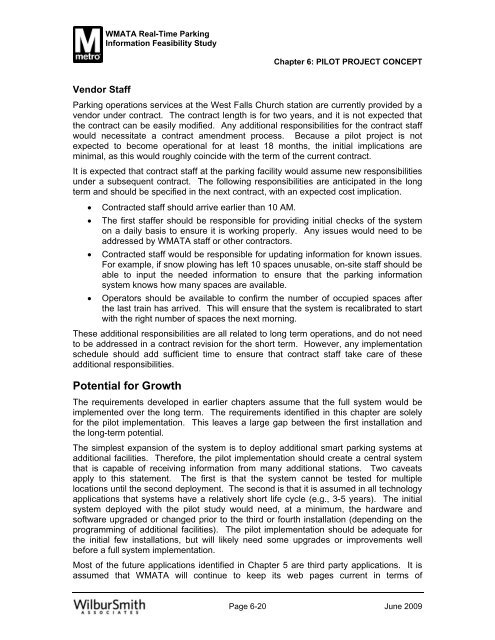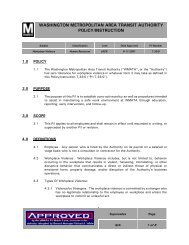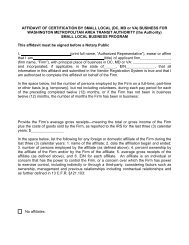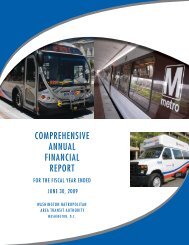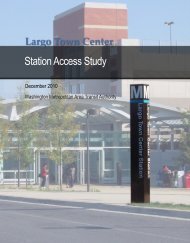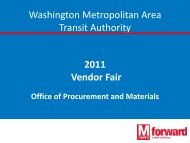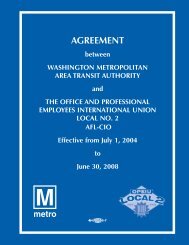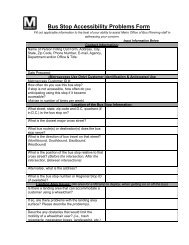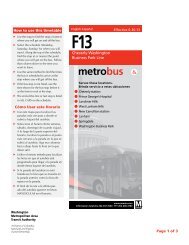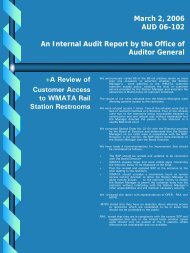feasibility study of real time parking information at ... - WMATA.com
feasibility study of real time parking information at ... - WMATA.com
feasibility study of real time parking information at ... - WMATA.com
You also want an ePaper? Increase the reach of your titles
YUMPU automatically turns print PDFs into web optimized ePapers that Google loves.
<strong>WMATA</strong> Real-Time Parking<br />
Inform<strong>at</strong>ion Feasibility Study<br />
Chapter 6: PILOT PROJECT CONCEPT<br />
Vendor Staff<br />
Parking oper<strong>at</strong>ions services <strong>at</strong> the West Falls Church st<strong>at</strong>ion are currently provided by a<br />
vendor under contract. The contract length is for two years, and it is not expected th<strong>at</strong><br />
the contract can be easily modified. Any additional responsibilities for the contract staff<br />
would necessit<strong>at</strong>e a contract amendment process. Because a pilot project is not<br />
expected to be<strong>com</strong>e oper<strong>at</strong>ional for <strong>at</strong> least 18 months, the initial implic<strong>at</strong>ions are<br />
minimal, as this would roughly coincide with the term <strong>of</strong> the current contract.<br />
It is expected th<strong>at</strong> contract staff <strong>at</strong> the <strong>parking</strong> facility would assume new responsibilities<br />
under a subsequent contract. The following responsibilities are anticip<strong>at</strong>ed in the long<br />
term and should be specified in the next contract, with an expected cost implic<strong>at</strong>ion.<br />
• Contracted staff should arrive earlier than 10 AM.<br />
• The first staffer should be responsible for providing initial checks <strong>of</strong> the system<br />
on a daily basis to ensure it is working properly. Any issues would need to be<br />
addressed by <strong>WMATA</strong> staff or other contractors.<br />
• Contracted staff would be responsible for upd<strong>at</strong>ing <strong>inform<strong>at</strong>ion</strong> for known issues.<br />
For example, if snow plowing has left 10 spaces unusable, on-site staff should be<br />
able to input the needed <strong>inform<strong>at</strong>ion</strong> to ensure th<strong>at</strong> the <strong>parking</strong> <strong>inform<strong>at</strong>ion</strong><br />
system knows how many spaces are available.<br />
• Oper<strong>at</strong>ors should be available to confirm the number <strong>of</strong> occupied spaces after<br />
the last train has arrived. This will ensure th<strong>at</strong> the system is recalibr<strong>at</strong>ed to start<br />
with the right number <strong>of</strong> spaces the next morning.<br />
These additional responsibilities are all rel<strong>at</strong>ed to long term oper<strong>at</strong>ions, and do not need<br />
to be addressed in a contract revision for the short term. However, any implement<strong>at</strong>ion<br />
schedule should add sufficient <strong>time</strong> to ensure th<strong>at</strong> contract staff take care <strong>of</strong> these<br />
additional responsibilities.<br />
Potential for Growth<br />
The requirements developed in earlier chapters assume th<strong>at</strong> the full system would be<br />
implemented over the long term. The requirements identified in this chapter are solely<br />
for the pilot implement<strong>at</strong>ion. This leaves a large gap between the first install<strong>at</strong>ion and<br />
the long-term potential.<br />
The simplest expansion <strong>of</strong> the system is to deploy additional smart <strong>parking</strong> systems <strong>at</strong><br />
additional facilities. Therefore, the pilot implement<strong>at</strong>ion should cre<strong>at</strong>e a central system<br />
th<strong>at</strong> is capable <strong>of</strong> receiving <strong>inform<strong>at</strong>ion</strong> from many additional st<strong>at</strong>ions. Two cave<strong>at</strong>s<br />
apply to this st<strong>at</strong>ement. The first is th<strong>at</strong> the system cannot be tested for multiple<br />
loc<strong>at</strong>ions until the second deployment. The second is th<strong>at</strong> it is assumed in all technology<br />
applic<strong>at</strong>ions th<strong>at</strong> systems have a rel<strong>at</strong>ively short life cycle (e.g., 3-5 years). The initial<br />
system deployed with the pilot <strong>study</strong> would need, <strong>at</strong> a minimum, the hardware and<br />
s<strong>of</strong>tware upgraded or changed prior to the third or fourth install<strong>at</strong>ion (depending on the<br />
programming <strong>of</strong> additional facilities). The pilot implement<strong>at</strong>ion should be adequ<strong>at</strong>e for<br />
the initial few install<strong>at</strong>ions, but will likely need some upgrades or improvements well<br />
before a full system implement<strong>at</strong>ion.<br />
Most <strong>of</strong> the future applic<strong>at</strong>ions identified in Chapter 5 are third party applic<strong>at</strong>ions. It is<br />
assumed th<strong>at</strong> <strong>WMATA</strong> will continue to keep its web pages current in terms <strong>of</strong><br />
Page 6-20 June 2009


